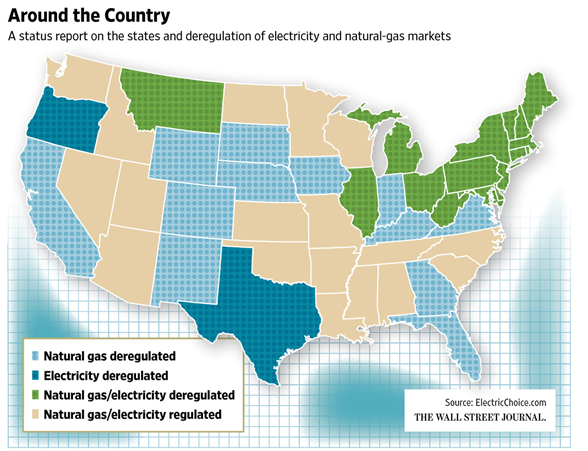Energy Procurement
Tip #7
By Ryan W. Ollie, CEM, CMVP, EIT, Manager of Energy Solutions, Facilities, Advocate Health Care
INTRODUCTION
Demand-side energy management is often prioritized over supply-side energy management by health care facility management professionals, because demand-side management is easier to control. Simply put, the potential savings from installing a variable-frequency drive is easier to understand than the mystery surrounding energy procurement and the deregulated retail energy market. However, to execute a balanced energy management program, you must not neglect the procurement side of the business. Before I cover some important tips, I will review some basic information about the energy market.
THE MARKET
The United States contains both regulated and deregulated markets. In regulated markets, utility companies are vertically integrated. In other words, regulated electric utilities own or control the generation, transmission, and distribution infrastructure of the power grid, while deregulated utility companies only own or control the distribution portion of the business.1
In deregulated markets, customers can purchase energy from a retail marketplace of suppliers versus only being able to purchase from the incumbent utility company in a regulated market. Since energy is traded as a commodity on an exchange, customers can implement various procurement strategies with their retailers that meet their budgetary constraints. While some customers are less risk averse and are willing to “float” along with the ever-changing market index prices, others value budget security and choose to lock in future utility delivery prices at a premium so that they can sleep better at night. Many customers use a combination of both extremes (often called a block and index procurement strategy) and lock in a portion of their load while letting the remainder float with the market index prices.2
TIPS
The following tips apply to customers that are in deregulated and semi-deregulated states.
The Retail Supplier and Customer Relationship: While securing low energy rates is extremely important, it is also equally important to select a partner that understands the complexity of the health care industry. All major suppliers should be able to provide similar market intelligence, but make sure that you are also informed about the different types of contract structures, billing options, and other value-added services that are available to customers.
Some organizations may want a supplier that offers one summary bill for hundreds of separate accounts to help streamline the payment process for the accounts payable department, while other organizations may want a supplier that creates annual budget forecasts for all of their accounts. Don’t be afraid to ask your supplier to provide an offering that meets the unique needs of your organization.
The Team: While some organizations set up formal committees of key decision makers (and sometimes external consultants) to handle energy procurement, not all organizations have the ability or resources to organize a group of this nature. At the very least, facility managers should try to develop relationships with key people in the supply chain and finance departments to add additional interdepartmental insight on best practices.
The Strategy: The level of detail required in a procurement strategy varies from organization to organization. Some may want a formal policy visible to senior leadership, while others allow the facility management team to create their own plan. Either way, document your strategy and periodically update it as the financial circumstances change within your organization.3
CONCLUSION
To be clear, I am not an energy procurement expert; however, the above tips have helped my organization and may also be helpful in your endeavors. No one has a crystal ball in regard to energy procurement. Each organization must manage their own risk and create a strategy that works within their budgetary constraints. For more background and details on health care energy procurement, please read ASHE’s monograph Energy Procurement: A Strategic Sourcing How-To Guide.

Source: ElectricChoice.com
1 Robin Deliso Woodcock, Regulated and Deregulated Energy Markets, Explained, (https://www.energysmart.enernoc.com/regulated-and-deregulated-energy-markets-explained, 2014).
2 Mark Mininberg & Walt Vernon, Energy Procurement: A Strategic Sourcing How-To Guide, (Chicago, ASHE, 2017), 11.
3 Mininberg & Vernon, Energy Procurement: A Strategic Sourcing How-To Guide, 9.
About the Author
 Ryan Ollie, CEM, CMVP, EIT currently serves as the Manager of Energy Solutions for Advocate Health Care and has been a part of their Support Services team since September of 2015. In this role, Ryan supports the Facilities, Design and Construction teams on all energy and water related items. Prior to joining Advocate Health Care, Ryan worked in various engineering roles within the MEP design and energy consulting space. In addition to these professional experiences, Ryan has also achieved the Certified Energy Manager (CEM), Certified Measurement & Verification Professional (CMVP) and Professional Engineer in Training (EIT) certifications.
Ryan Ollie, CEM, CMVP, EIT currently serves as the Manager of Energy Solutions for Advocate Health Care and has been a part of their Support Services team since September of 2015. In this role, Ryan supports the Facilities, Design and Construction teams on all energy and water related items. Prior to joining Advocate Health Care, Ryan worked in various engineering roles within the MEP design and energy consulting space. In addition to these professional experiences, Ryan has also achieved the Certified Energy Manager (CEM), Certified Measurement & Verification Professional (CMVP) and Professional Engineer in Training (EIT) certifications.
Have a tip you want to share? We’d love to hear from you. Contact Kara Brooks at kbrooks@aha.org.
